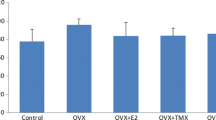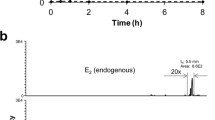Abstract
Brain-enhanced delivery and sustained release of estradiol (E2) may be potentially useful in the treatments of vasomotor hot flushes and prostatic adenocarcinoma and for fertility regulation. Therefore, we have evaluated a redox-based estradiol-chemical delivery system (E2-CDS) for the brain. The mechanism of this drug delivery is based on an interconvertible dihydropyridine⇌pyridinium salt redox reaction. In this study, we investigated the dose- and time-dependent effects of E2-CDS on the tissue distribution of E2-Q+ and E2, the inactive (intermediate) and active metabolites, respectively, of the E2-CDS. Ovariectomized rats received a single iv injection of E2-CDS at 0.01, 0.1, or 1.0 mg/kg or an E2 dose of 0.7 mg/kg or the drug's vehicle, 2-hydroxypropyl-β-cyclodextrin (HPCD), on day 0. Tissue samples including brain and peripheral tissues were then analyzed for both E2-Q+ and E2 at 1, 7, 14, 21, or 28 days following the E2-CDS administration. Initially, both E2-Q+ and E2 were detected in all tissues analyzed. The dose-distribution and time-course study demonstrates that (1) at 24 hr (1 day) after administration of E2-CDS, all tissues showed a dose-proportional increase in concentrations of E2-Q+ and E2; (2) the enzymatic oxidation of E2-CDS to E2-Q+ was dose dependent over the 100-fold dose range examined; and (3) the disappearance of E2-Q+ as well as E2 was slow in whole brain and hypothalamus, with an apparent t \(\frac{1}{2}\) = 8–9 days, while both of these metabolites were rapidly cleared from plasma, liver, fat, anterior pituitary, kidney, lung, heart, and uterus. Finally, when the kinetic behaviors of E2-CDS and E2 were compared on molar basis, the E2-CDS (1.0-mg/kg dose) produced E2 concentrations in brain tissue which were 81- and 182-fold greater than those achieved following equimolar E2 (0.7 mg/kg) injection at 1 and 7 days, respectively. These data demonstrate that the E2-CDS is much more effective than E2 itself in delivering the estrogen to the brain. Collectively, these data support the concept of the brain-enhanced delivery and sustained release of E2 using the redox-based chemical delivery system.
Similar content being viewed by others
REFERENCES
G. E. Abraham. Acta Endocrinol. (Suppl.) 183:1–42 (1974).
H. Davson. J. Physiol. Lond. 255:1–29 (1976).
W. M. Partridge and L. J. Meitus. J. Clin. Invest. 64:145–154 (1979).
J. Spona and W. Schneider. Acta Obstet. Gynecol. Scand. (Suppl.) 65:33–38 (1977).
D. Pfaff and M. Keiner. J. Comp. Neurol. 151:121–158 (1973).
F. Murad and R. C. Haynes, Jr. In A. G. Gilman, L. S. Goodman, T. W. Rall, and F. Murad (eds.), The Pharmacological Basis of Therapeutics, Macmillan, New York, 1985, pp. 1412–1439.
D. B. Thomas. Cancer 62:1755–1767 (1988).
I. Persson. Acta Obstet. Gynecol. Scand. (Suppl.) 130:59–66 (1985).
V. Drill and C. W. Calhoun. JAMA 219:583–596 (1972).
W. H. W. Inman and M. P. Vessey. Br. J. Med. 2:193–199 (1968).
R. T. Burkman. Fertil. Steril. (Suppl.) 49:39S–50S (1988).
S. Campbell and M. Whitehead. Clin. Obstet. Gynaecol. 4:31–47 (1977).
S. P. Kalra and P. S. Kalra. Endocrinology 106:390–397 (1980).
R. L. Goodman and E. Knobil. Neuroendocrinology 32:57–63 (1981).
B. R. Rao, A. A. Geldof, C. L. van der Wilt, and H. J. de Voogt. Prostate 13:69–78 (1988).
L. W. Christensen and L. G. Clemens. Endocrinology 95:984–990 (1974).
N. Bodor, J. McCormack, and M. E. Brewster. Int. J. Pharm. 35:47–59 (1987).
N. Bodor and M. E. Brewster. Pharmacol. Ther. 19:337–386 (1983).
M. H. Rahimy, J. W. Simpkins, and N. Bodor. Drug Design Deliv. 6:29–40 (1990).
M. H. Rahimy, J. W. Simpkins, and N. Bodor. Pharm. Res. 7:1107–1112 (1990).
M. H. Rahimy and J. W. Simpkins. Soc. Neurosci. Abstr. 14:1038 (1988).
M. H. Rahimy, N. Bodor, and J. W. Simpkins. J. Steriod Biochem. 33:179–187 (1989).
G. Mullersman, H. Derendorf, M. E. Brewster, K. S. Estes, and N. Bodor. Pharm. Res. 5:172–177 (1988).
J. W. Simpkins, J. McCormack, K. S. Estes, M. E. Brewster, E. Shek, and N. Bodor. J. Med. Chem. 29:1809–1812 (1986).
R. J. Traystman. In N. A. Mortillaro (ed.), The Physiology and Pharmacology of the Microcirculation, Academic Press, New York, 1983, Vol. 1, pp. 237–298.
W. R. Anderson, J. W. Simpkins, M. E. Brewster, and N. Bodor. Life Sci. 42:1493–1502 (1988).
N. Bodor. Ann. N.Y. Acad. Sci. 507:289–306 (1987).
N. Bodor, H. H. Farag, and M. E. Brewster. Science 214:1370–1372 (1981).
B. S. McEwen. Neurochem. Res. 13:663–669 (1988).
A. Maggi and J. Perez. Life Sci. 37:893–906 (1985).
Author information
Authors and Affiliations
Rights and permissions
About this article
Cite this article
Rahimy, M.H., Simpkins, J.W. & Bodor, N. Dose and Time-Course Evaluation of a Redox-Based Estradiol-Chemical Delivery System for the Brain. I. Tissue Distribution. Pharm Res 7, 1061–1067 (1990). https://doi.org/10.1023/A:1015999318729
Issue Date:
DOI: https://doi.org/10.1023/A:1015999318729




